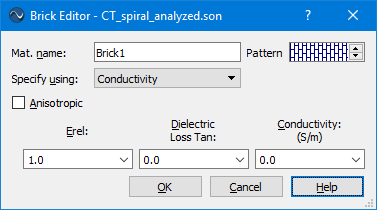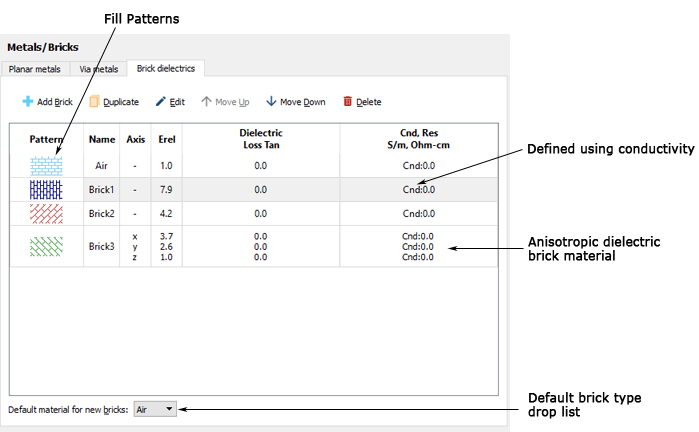Just as it is possible to define a variety of metal types, each with different properties, it is also possible to define a variety of dielectric brick materials. Dielectric brick materials are defined using the parameters below:
Erel: The relative dielectric constant (εr). The ratio (ε/εo), where ε is the real part of the permittivity of the dielectric layer material, and εo is the permittivity of free space. The ratio is dimensionless.
Dielectric Loss Tan: The dielectric loss tangent. The ratio (ε’’/ε’), where ε = ε’ - jε’’, and ε is the complex permittivity of the dielectric layer material. The ratio is dimensionless.
Conductivity: Dielectric conductivity, σ, where σ is the conductivity of the dielectric. The default unit is S/m. You may define your dielectric loss using conductivity or resistivity. To use conductivity, you should select “Conductivity” from the Specify Using drop list.
Resistivity: Resistivity = 1.0 / conductivity. Resistivity has a default unit of Ohm-cm.You may define your dielectric loss using conductivity or resistivity. To use resistivity, you should select “Resistivity” from the Specify Using drop list.
To define a new dielectric brick material, or to modify the characteristics of an existing material, you use the Brick Editor dialog box, which is opened by selecting Circuit - Settings from the main menu of the project editor,clicking on Metals/Bricks in the sidebar menu of the Circuit Settings dialog box, then selecting the Brick dielectrics tab in the Metals/Bricks page, then clicking on the Add Brick button to add a new brick or on the Edit button if a presently defined dielectric is selected in the list which appears in this tab.

The Brick dielectrics page, shown below, shows all the dielectric brick materials previously defined, the color/fill pattern assigned to each brick material, and whether the material is isotropic or anisotropic. To modify the settings for a particular dielectric brick material, select it in the list, then click on the Edit button. You may also double-click on a entry to open the Brick Editor.

If the brick type is isotropic only one set of parameters, X, will be set. Conversely, if the brick material is set to anisotropic, each parameter is defined separately for the X, Y, and Z dimensions. If you wish to make a brick material anisotropic, click on the Anisotropic checkbox.
Note that Electrical Loss may be defined using Conductivity or Resistivity. Which parameter is used is indicated by the prefix appearing before the value Conductivity/Resistivity column as pictured above.
The “default” material used when new dielectric bricks are created can also be set in the Brick Materials dialog box. Select a brick type from the Default for add bricks drop list. Once the default material has been set, all bricks created thereafter will be made of that material.